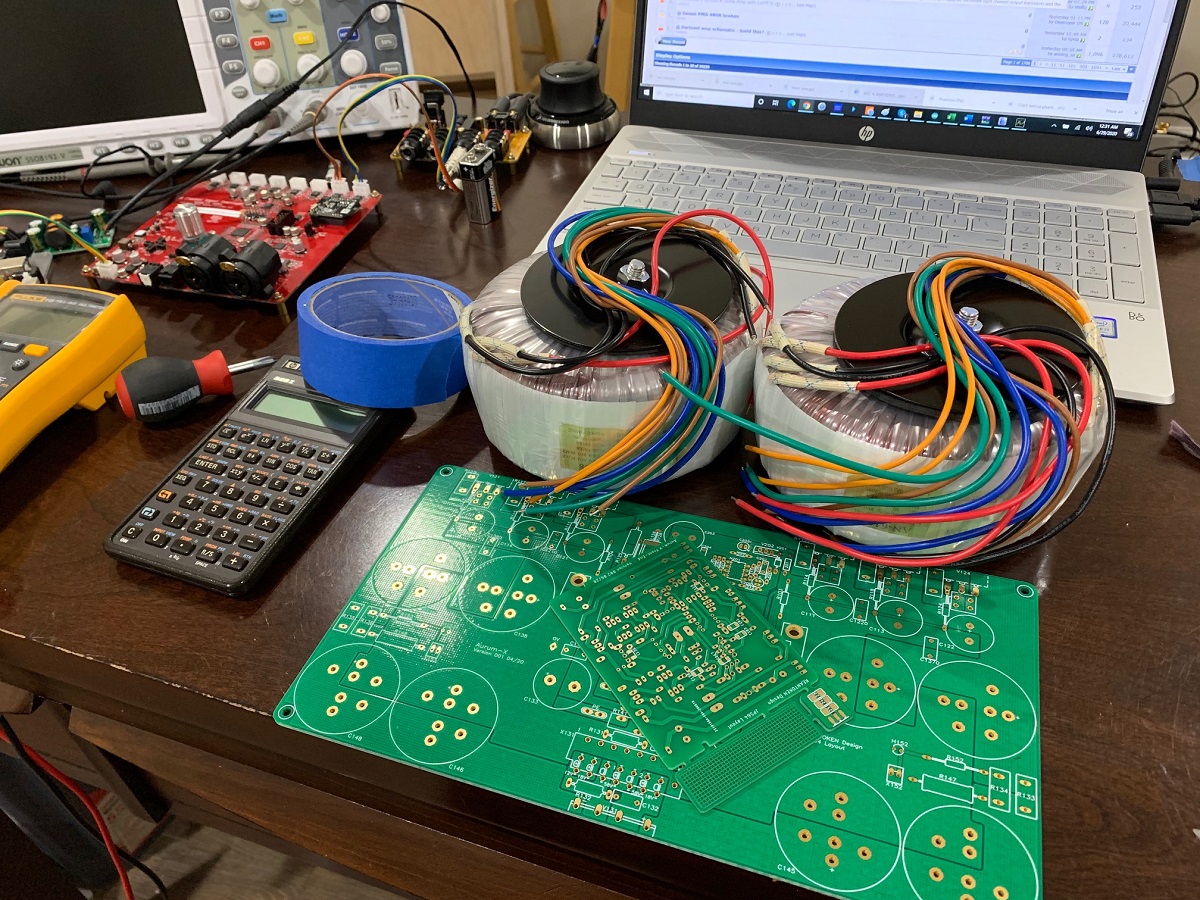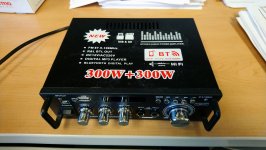- How do manufacturers get away with ridiculous claims? I will use any crap as a test amp but my latest acquisition takes the biscuit. A Samsung A/V amp claims to consume 75w.
However, according to the specifications, using some highly-classified nuclear cold-fusion technology it is apparently capable of delivering 170w to the subwoofer channel. 166w to the centre speaker, 333w to the fronts and 333w to the rears.
My old Yamaha YST-PSW-60 subwoofer, claims to consume 70w, and output 50w. Strip it down and you'll find "Taiwan 25w" stamped on the driver.
I understand the difference between RMS and PMPO but this flagrant deception is ridiculous. It's akin to Ford claiming the new Focus does 15,000 mpg (when dropped from a C130 with the engine off).
Rant over.
Member
Joined 2009
Paid Member
Don't feel bad, the difference between 50W and 25W will very likely be irrelevant for your use of it, because our ears (like our eyes) have a non-linear sensitivity. If you aren't running screaming from the room at 25W then cranking it to 50W won't move the needle much further. Having good speakers is where you should focus your efforts.
fyi - competitive pressures force all these guys to 'play the game' with specs.
fyi - competitive pressures force all these guys to 'play the game' with specs.
Take this chinese crap...its advertised as 300 + 300 watts. Not even 2x300 watts, its claiming plus, indicating dual mono. 300 watts my ***. I opened it just out of curiosity, and it has chip amp specified as 4x7 watts, configured in bridged mode, so 2x14 watts. Max. Its powered by tiny little power transformer, yes transformer, not switching power supply, so you can imagine how tiny that transformer is if it fits in the small box. Likely no more than 20 watts. Yet it still manages to make 300 + 300 watts on music signal out!
This is where we are at. 🙁
This is where we are at. 🙁
Attachments
That's pretty amusing 300W 🙂 Maybe the "W" refers to something else?
I am preparing for a 300W amp and got some new Antek 600VA transformers for it and they are probably bigger than the box above.

I am preparing for a 300W amp and got some new Antek 600VA transformers for it and they are probably bigger than the box above.
Ahh, the ole "lots of watts" dilemma....
Using misleading claims to impress the buyer isn't anything new.
The average person has no idea of such things, just brainwashed into thinking "more is better".
Mary Dugan, a housewife, is led to believe such things, so she spends more as a result. (hyped marketing does wonders for unloading your wallet)
It's been going on for ages now...
An old 1960's Zenith commercial of one of their console stereos touts "And now, with the new 240W amplifier!... producing an astounding 240 watts of PEAK music power!"
When in reality, that amp perhaps yields a miserable 25 watts on a good day.
The same brainwashing goes for automobiles - "Zero to 60 in 3 seconds"
Buy it!... you'll pass that slow old lady in front of you... How dare she motor along on the highway at the legal limit of 50MPH!
It all follows the pattern of "rush to the grave" - hurry hurry!... my internet is slow!... I need a quad-core processor!
I'm certainly not in some rush to the grave, nor do I need 600 watts to enjoy my music, when 10 is loud enough.
Using misleading claims to impress the buyer isn't anything new.
The average person has no idea of such things, just brainwashed into thinking "more is better".
Mary Dugan, a housewife, is led to believe such things, so she spends more as a result. (hyped marketing does wonders for unloading your wallet)
It's been going on for ages now...
An old 1960's Zenith commercial of one of their console stereos touts "And now, with the new 240W amplifier!... producing an astounding 240 watts of PEAK music power!"
When in reality, that amp perhaps yields a miserable 25 watts on a good day.
The same brainwashing goes for automobiles - "Zero to 60 in 3 seconds"
Buy it!... you'll pass that slow old lady in front of you... How dare she motor along on the highway at the legal limit of 50MPH!
It all follows the pattern of "rush to the grave" - hurry hurry!... my internet is slow!... I need a quad-core processor!
I'm certainly not in some rush to the grave, nor do I need 600 watts to enjoy my music, when 10 is loud enough.
I protest!Mary Dugan, a housewife, is led to believe such things, so she spends more as a result.
Mary Dugan is innocent! 🙂
Attachments
It's been going on for years, back in 1978 I worked in a stereo store fixing TV's and stereos. A Rep from Pioneer (Pioneer sales man ) came in with these new car speakers that he said could handle 150W per channel. I said " Do you mean that I can hook them up to this 60W per channel Pioneer receiver and they won't blow up?", he said yes. The receiver had power meters on it and the speakers stopped working when the meters were peaking at about 7W. I know the meters were probably meant to read for 8 ohm speakers, but that would be 14W peak into 4 ohm, not 150.
He left with his broken speakers and no sale.
He left with his broken speakers and no sale.
Thanks God I´m in the Music Instruments market, selling to the Pros, where that is simply not possible.
Mary Dugan , Housewife, has no clue as to what a Watt is, never ever heard a 300 or 600 or whatever Watts amp so she can not even compare , (the most basic way of measuring) and specially that inflated watts amp or system is alone in her living room.
While Musicians are always playing a few feet away from a very loud and very stable sound source, very noisy: the drummer.
Drummers have been using basically same kits and playing technique since forever, think the 40´s on, powered by about same "motors" (themselves), hitting them with drumsticks and foot pedals ... a quite consistent sound source which Guitar and Bass amplifiers must at least match ... not an easy task.
Rule of thumb is, you need real 60W RMS through efficient Guitar speakers to match a Rock drummer, 100W to feel comfortable if you want to play clean.
A Bass player will be barely heard with 60W, about match it with 100W and be comfortable with 150/200W RMS, always through efficient speakers, think > 94-96 dB/W for Bass and 96-99 dB for Guitar
Some Guitar players can use 30W but through highest sensitivity speakers (VOX AC30 through Celestion Blue) *and* playing at the edge of clipping or beyond.
And Musicians play together to begin with inside a band, and *often* many bands play together (Club/theater/stadium/rehearsal room), so lots of amps and speakers side by side where at least one or two "good" ones will be present.
So when Johnny Arpeggio shows up with a "200-300-500W" amplifier, we are talking "Chinese" or PMPO Watts, to boot through cheesy speakers and there is present a 100W Marshall/Fender/Peavey/Laney/Ampeg amp with matching speakers he will be laughed at all the way to his grave.
Most a MI amp manufacturer can cheat/lie is claim "120W" (mind you, not even 150) for a 100W amp. No room for more.
And a true 100W tube amp (Marshall Plexi, Twin Reverb to cite a couple classic examples) will show some 350-375W consumption on the back panel, no magic energy multiplying here.
And a 100W transistor amp will show around 160W consumption, same thing.
Mary Dugan , Housewife, has no clue as to what a Watt is, never ever heard a 300 or 600 or whatever Watts amp so she can not even compare , (the most basic way of measuring) and specially that inflated watts amp or system is alone in her living room.
While Musicians are always playing a few feet away from a very loud and very stable sound source, very noisy: the drummer.
Drummers have been using basically same kits and playing technique since forever, think the 40´s on, powered by about same "motors" (themselves), hitting them with drumsticks and foot pedals ... a quite consistent sound source which Guitar and Bass amplifiers must at least match ... not an easy task.
Rule of thumb is, you need real 60W RMS through efficient Guitar speakers to match a Rock drummer, 100W to feel comfortable if you want to play clean.
A Bass player will be barely heard with 60W, about match it with 100W and be comfortable with 150/200W RMS, always through efficient speakers, think > 94-96 dB/W for Bass and 96-99 dB for Guitar
Some Guitar players can use 30W but through highest sensitivity speakers (VOX AC30 through Celestion Blue) *and* playing at the edge of clipping or beyond.
And Musicians play together to begin with inside a band, and *often* many bands play together (Club/theater/stadium/rehearsal room), so lots of amps and speakers side by side where at least one or two "good" ones will be present.
So when Johnny Arpeggio shows up with a "200-300-500W" amplifier, we are talking "Chinese" or PMPO Watts, to boot through cheesy speakers and there is present a 100W Marshall/Fender/Peavey/Laney/Ampeg amp with matching speakers he will be laughed at all the way to his grave.
Most a MI amp manufacturer can cheat/lie is claim "120W" (mind you, not even 150) for a 100W amp. No room for more.
And a true 100W tube amp (Marshall Plexi, Twin Reverb to cite a couple classic examples) will show some 350-375W consumption on the back panel, no magic energy multiplying here.
And a 100W transistor amp will show around 160W consumption, same thing.
Don't feel bad, the difference between 50W and 25W will very likely be irrelevant for your use of it, because our ears (like our eyes) have a non-linear sensitivity. If you aren't running screaming from the room at 25W then cranking it to 50W won't move the needle much further. Having good speakers is where you should focus your efforts.
fyi - competitive pressures force all these guys to 'play the game' with specs.
Not buying any of that. If I order a 10oz fillet stake from a menu, don't bring me a 4oz burger and tell me my stomach can't tell the difference.
the ear is logarithmic.
so to get twice as loud requires ten times more watts.
so 100 watt amp is twice as loud as 10 watt.
so to get twice as loud requires ten times more watts.
so 100 watt amp is twice as loud as 10 watt.
Nothing new here really. During the 1970s the "receiver wars" raged in the US where each manufacturer made ever more outrageous claims of power output. These were, of course, totally spurious, there being no standardised measurement, hence peak power figures into low impedance loads were the order of the day. Fabulous looking machines though.
It was ended when the federal trade commission introduced the standard continuous power measurement in 1975. Seems like the Chinese manufacturers didn't get the memo 🙂
It was ended when the federal trade commission introduced the standard continuous power measurement in 1975. Seems like the Chinese manufacturers didn't get the memo 🙂
they got away with it because most music has peaks.
so for very brief periods the power supply could manage powerful burst of power.
of course with continous sine waves or sound it just fell apart.
so for very brief periods the power supply could manage powerful burst of power.
of course with continous sine waves or sound it just fell apart.
The best way to measure power is to boil a glass of water and time it 🙂
That's funny.
Last night I used that same idea to clean the microwave oven cavity.
Boil a cup of water (in a pyrex container) for about 5 minutes.
Makes wiping out the inside a lot easier.
I've had a post deleted for being 'political'. But I still feel the need to respond to what appears to be a couple of anti-Chinese jabs. Some of these products may be made in China but they are not responsible for the marketing. Of the products I've mentioned: Samsung is North Korean. Yamaha is Japanese. Texas Instruments is American.
- How do manufacturers get away with ridiculous claims? I will use any crap as a test amp but my latest acquisition takes the biscuit. A Samsung A/V amp claims to consume 75w.
However, according to the specifications, using some highly-classified nuclear cold-fusion technology it is apparently capable of delivering 170w to the subwoofer channel. 166w to the centre speaker, 333w to the fronts and 333w to the rears.
My old Yamaha YST-PSW-60 subwoofer, claims to consume 70w, and output 50w. Strip it down and you'll find "Taiwan 25w" stamped on the driver.
I understand the difference between RMS and PMPO but this flagrant deception is ridiculous. It's akin to Ford claiming the new Focus does 15,000 mpg (when dropped from a C130 with the engine off).
Rant over.
Those 330 watts are fed into a 2-inch speaker🙁
Don't give me ideas like this! That will make the most 'musical' of all cups of tea I can ever drink.The best way to measure power is to boil a glass of water and time it 🙂
Last edited:
A Samsung A/V amp claims to consume 75w.
However, according to the specifications, it is apparently capable of delivering 170w to the subwoofer channel. 166w to the centre speaker, 333w to the fronts and 333w to the rears.
There are 2 separate things going on here..
1. Yes the rated audio output specs are nonsense, often in the user manual they will state the actual RMS specs which will be a fraction of what is in the advertising and there will often be an * attached where you will learn the unit can only deliver full power into 2 channels at a time, with all channels driven the output drops significantly.
2. The rated AC power consumption is an average steady state level that does not factor in peak demand at all which could be 10's or 100's of times higher, and with no accompanying data it is unknown what kind of program material was used, how many outputs were in use, and how hard the unit was pushed. Music is typically much more dynamic than a sine wave so AC consumption cannot be directly compared to audio output anyway, but no electrical device is more than 100% efficient either so this rating is also pretty much meaningless.
the ear is logarithmic.
so to get twice as loud requires ten times more watts.
so 100 watt amp is twice as loud as 10 watt.
I thought is was an amplifier's gain that determines how loud, and watts how much drive into difficult loads.
- Home
- Amplifiers
- Solid State
- What's with the watts?

